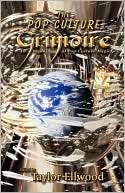
Often, I listen politely to a buffet of beliefs and hypotheses at various pagan mixers. All too often, though, I stop the conversation with this question: “That’s great that you believe that. So what do you do with it?” This usually results in the person turning an odd shade of pink, muttering something and shuffling away. I know I would not have this experience with the authors in The Pop Culture Grimore. This book, an anthology of seventeen authors, consists of people who would look me in the eye and give me a straight and genuinely interesting answer to my question. Not only does this speak to magical innovation, TPCG speaks to actual magical practice – a delightful highlight of all books printed by Megalithica Press.
The selections of author and topic are as delightful as they are diverse, and the very presence of this anthology speaks to a daring concept in magical practice: creativity. There is a strong school of thought that there is a “proper” way to do magic, and while certainly there are elements (and elementals) and energy principles behind any successful work, magic/ritual is like any other art: once you truly master the basics you know what you can really do with it. By rethinking pop culture within the framework of magic, you are then forced to rethink magic within the framework of pop culture. The imaginative approach is all-too-often discouraged by traditionalists, a frustrating reality in a medium where the most powerful works evolve from the power to imagine.
Each essay has its own appeal. The Torchwood fan in me squeed at the argument for Jack Harkness as a mythical symbol for death, while most of the writing on anime-based concepts confused me because anime confuses me. Jackie Schmitt’s recounting of a thoughtform she empowered to resolve issues in a digital medium is both compelling and frightening, and Diana Rice’s Elvisinian Mysteries prompted me to pull up my copy of “Walking in Memphis” on Itunes. While in some cases pop culture concepts intertwined with another peculiar energy known as “fandom” others stood independently of the concept, taking secular creations and repurposing them for ritual, like Lisa Mc Sherry’s essay Popular Music as Ritual and Elizabeth Barrette’s piece on designing ritual to allow for a pop culture concept.
It might be argued that pop culture magic is somehow “lazy” or that the use of “intent” is too casual to truly fit a magical context. While this might be true in some cases, I do not think so for most examples in this book. Intent is, after all, a magical basic to be mastered. This attitude also suggests an aversion to pleasure in ritual, which makes little sense if you want effective magical impact. Because pleasure generates strong metaphysical energy, it only makes sense for a practitioner to choose something he or she enjoys.
Whether rolling dice on a table, playing X-box with intention, or just having a laugh at late night television, these writers have made their passions magical – and in more way than one, brought them to life. Well worth a read, even if you struggle with the concept of using pop-culture in magic. There’s far more to this than the deification of Buffy Summers. While I may not agree with all of it, the very presence of this anthology refreshed my mind and gave me a renewed energy towards my own magic.
~review by Diana Rajchel
Editor: Taylor Ellwood
Megalithica Books, 2008
pp. 157 $20.99 US
